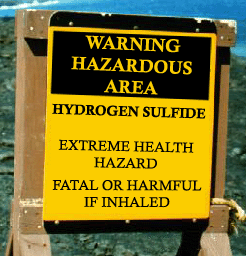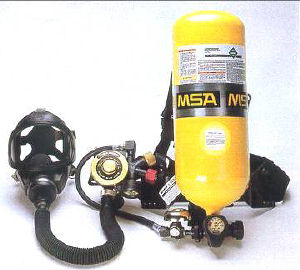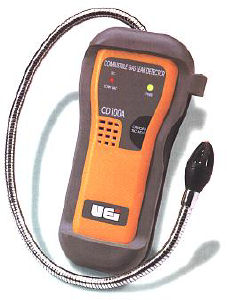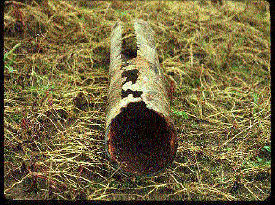Note: It is not the
intent of this section to create an H2S contingency plan.
Hydrogen Sulfide or sour gas (H2S) is a flammable, colorless gas that is
toxic at extremely low concentrations. It is heavier than air, and may accumulate in low-lying areas. It smells
like "rotten eggs" at low concentrations and causes you to quickly lose your sense of smell. Many areas
where the gas is found have been identified, but pockets of the gas can occur anywhere. [More]
Iron sulfide is a byproduct of many production operations and may spontaneously combust with air.
Flaring operations associated with H2S production will generate Sulfur Dioxide (S02),
another toxic gas.
Active monitoring for hydrogen sulfide gas and good planning and training programs for workers are the best ways
to prevent injury and death.
Also see: NIOSH
Classification
of H2S Hazard Areas.
|

Fig. 1. Hydrogen sulfide warning sign: Warning Hazardous Area is in yellow letters on a black background. In black letters on a yellow background, the sign says Hydrogen Sulfide, Extreme Health Hazard, Fatal or Harmful if Inhaled.
|
 Release
of H2S Release
of H2S |
All personnel working in an area where concentrations of Hydrogen Sulfide may exceed the 10 Parts Per Million
(PPM) should be provided with training before beginning work assignments.
Potential Hazard:
- H2S exposure greater than the Permissible Exposure Limit (PEL)
Possible Solutions:
Implement an H2S contingency plan (see API) including, but not limited to:
- Appropriate instruction in the use of hydrogen sulfide safety equipment to all personnel present at all
hydrogen sulfide hazard areas.
- Gas detection where hydrogen sulfide may exist.
- Appropriate respiratory protection for normal and emergency use. Respiratory Protection Standard, [29 CFR 1910.134]
(H2S).
For emergency response information, see Hazardous Waste and Emergency Response (HAZWOPER)
Standard, [29 CFR 1910.120].

Fig. 2. SCBA

Fig. 3. Gas detector |
Comprehensive training should be provided for workers in H2S operations.
Example topics include:
- Identification of the characteristics, sources, and hazards of Hydrogen Sulfide.
- Proper use of the Hydrogen Sulfide detection methods used on the site.
- Recognition of, and proper response to, Hydrogen Sulfide warnings at the workplace.
- Symptoms of Hydrogen Sulfide exposure.
- Proper rescue techniques and first-aid procedures to be used in a Hydrogen Sulfide exposure.
- Proper use and maintenance of personal protective equipment. Demonstrated proficiency in using PPE should
be required.
- Worker awareness and understanding of workplace practices and maintenance procedures to protect personnel
from exposure to hydrogen sulfide.
- Wind direction awareness and routes of egress.
- Confined space and enclosed facility entry procedures.
- Locations and use of safety equipment.
- Locations of safe briefing areas.
- Use and operation of all Hydrogen Sulfide monitoring systems.
- Emergency response procedures, corrective action, and shutdown procedures.
- Effects of Hydrogen Sulfide on the components of the Hydrogen Sulfide handling system.
- The importance of drilling fluid treating plans prior to encountering Hydrogen Sulfide.
Additional Information:
-
RP 49, Recommended Practice for Drilling and Well Servicing Operations
Involving Hydrogen Sulfide. American Petroleum Institute (API),
(2001, May/Reaffirmed 2007, March). Includes well drilling,
completion, servicing, workover, downhole maintenance, and plug and
abandonment procedures conducted with hydrogen sulfide present in the
fluids being handled.
-
Recommended Safe
Procedures and Guidelines for
Oil and Gas Well Servicing.
Association of Energy Services Companies (AESC).
- OSHA Fact Sheet. 54 KB
PDF, 2 pages.
-
Use of Anchors and Guywires. 72 KB
PDF, 12 pages.
-
Use of Compressed Gas Cylinders. 12 KB
PDF, 3 pages.
-
Crane Operation. 15 KB
PDF, 4 pages.
-
Proper Electrical Safety (including hot sticks). 17 KB
PDF, 4 pages.
-
Hot Work. 9 KB
PDF, 2 pages.
-
Fall Protection Systems. 16 KB
PDF, 4 pages.
-
H2S - Hydrogen Sulfide. 14 KB
PDF, 2 pages.
-
Respirator Usage. 68 KB
PDF, 18 pages.
-
Use of wooden, metal and plastic (fiberglass) portable ladders. 17
KB
PDF, 4 pages.
-
Scaffolding. 23 KB
PDF, 7 pages.
-
Vehicle Operation. 10 KB
PDF, 2 pages.
Accessibility Assistance: Contact the OSHA Directorate of Technical Support and Emergency Management at 202-693-2310 for assistance accessing PDF
materials.
|
 Metal
Fatigue Metal
Fatigue |

Fig. 4. H2S metal fatigue
|
Metal fatigue, including hydrogen embrittlement or
sulfide stress cracking, can result in
a release of hydrogen sulfide gas.
Potential Hazard:
- Being exposed to Hydrogen Sulfide.
- Getting Injured due to equipment failure.
Possible Solutions:
- Select materials in accordance with the MR0175/ISO15156 criteria for H2S service.
- MR 0175, Metals for Sulfide Stress
Cracking and Stress Corrosion Cracking Resistance in Sour Oilfield
Environments. National Association of Corrosion Engineers (NACE),
(2003, December) [Also ISO 15156, Petroleum and
natural gas industries—Materials for use in H2S
containing environments in oil and gas production, International
Standards Organization (ISO)].
-
About MR 0175.
Reviewed and approved 15 proposals for change to the standard.
Treat drilling fluids to chemically reduce corrosion failures.
|
 Accumulation
of H2S Accumulation
of H2S |
It is possible for hydrogen sulfide gas to accumulate in any low or enclosed area, such as a gas venting
system, mud system, cellars, pits, and tanks.
Potential Hazard:
- Being exposed to Hydrogen Sulfide.
Possible Solutions:
- Provide adequate ventilation for the removal of any accumulation of H2S.
- Implement effective
confined space
entry program.
|
 Additional
Information Additional
Information |
Additional guidance materials are available from:
-
RP 49, Recommended Practice for Drilling and Well Servicing Operations
Involving Hydrogen Sulfide. American Petroleum Institute (API),
(2007, March). Includes well drilling,
completion, servicing, workover, downhole maintenance, and plug and
abandonment procedures conducted with hydrogen sulfide present in the
fluids being handled.
- Spec 6A, Specification for Wellhead and Christmas Tree Equipment (includes Errata 3 dated June
2006). 19th Edition. (2004, July). [Also ISO10423:2003] Specifies requirements and gives recommendations for the performance,
dimensional and functional interchangeability, design, materials,
testing, inspection, welding, marking, handling, storing, shipment and
purchasing, of wellhead and christmas tree equipment for use in the
petroleum and natural gas industries.
- Spec 6A 718, Specification of Nickel Base Alloy 718 (UNS N07718) for Oil and Gas Drilling and Production
Equipment (includes Addendum dated March 2006). 1st Edition. (2004, March). Provides specification
requirements for Nickel Base Alloy 718 (UNS N07718) that are intended
to supplement the existing requirements of API Spec 6A and ISO 10423.
These additional specification requirements include detailed process
control requirements and detailed testing requirements.
- For additional information, see
Publications on the API web site.
-
Recommended Safe
Procedures and Guidelines for
Oil and Gas Well Servicing.
Association of Energy Services Companies (AESC).
- OSHA Fact Sheet. 54 KB
PDF, 2 pages.
-
Use of Anchors and Guywires. 72 KB
PDF, 12 pages.
-
Use of Compressed Gas Cylinders. 12 KB
PDF, 3 pages.
-
Crane Operation. 15 KB
PDF, 4 pages.
-
Proper Electrical Safety (including hot sticks). 17 KB
PDF, 4 pages.
-
Hot Work. 9 KB
PDF, 2 pages.
-
Fall Protection Systems. 16 KB
PDF, 4 pages.
-
H2S - Hydrogen Sulfide. 14 KB
PDF, 2 pages.
-
Respirator Usage. 68 KB
PDF, 18 pages.
-
Use of wooden, metal and plastic (fiberglass) portable ladders. 17
KB
PDF, 4 pages.
-
Scaffolding. 23 KB
PDF, 7 pages.
-
Vehicle Operation. 10 KB
PDF, 2 pages.
- MR 0175, Metals for Sulfide Stress
Cracking and Stress Corrosion Cracking Resistance in Sour Oilfield
Environments. National Association of Corrosion Engineers (NACE),
(2003, December) [Also ISO 15156, Petroleum and
natural gas industries—Materials for use in H2S
containing environments in oil and gas production, International
Standards Organization (ISO)].
-
About MR 0175. Consists of three standards and four technical
corrigenda (addenda).
State Programs:
Training Programs
- Drilling Technology Series.
Petroleum Extension Service (PETEX), University of Texas at Austin.
- Unit I: The Rig and Its Maintenance
- Unit II: Normal Drilling Operations
- Unit III:
Non-routine Operations
- Unit IV: Man Management and Rig Management
-
ASC Z390.1, Accepted Practices for Hydrogen Sulfide Safety Training Programs. American Society of Safety
Engineers (ASSE), (2006, June).
H2S Training and Information Links
-
2008 Catalog Pages by Topic. American Petroleum Institute (API),
(2007). Download PDF files of the 2008 Publications Programs and
Services.
- International Association of Drilling Contractors (IADC)
Accessibility Assistance: Contact the OSHA Directorate of Technical Support and Emergency Management at 202-693-2310 for assistance accessing PDF
materials.
|
|
|
